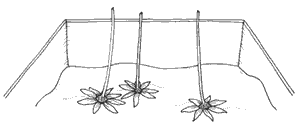Using Zinnias in the Yard
Because they are available in such a wide variety of sizes and colors, zinnias are most versatile for use around the yard. Smaller types do best in the front of beds and borders, and the tall types belong at the back. Mix them in with shrubs, other annuals or perennials. Use them to line walks and property boundaries. Plant entire beds of them just for cutting. Dwarf varieties like ‘Mini’, ‘Thumbelina’ ‘Button’, and ‘Peter Pan’ make good potted houseplants, or windowbox display. They are ideal for small patio containers. ‘Angustifolia’ types make good groundcovers and do well in containers as well. Because they require strong sun, zinnias are not suitable for a greenhouse.
ENJOYING ZINNIAS
 |
Zinnias Attract Wildlife
Zinnias bring lots of wildlife visitors to your yard. All types, but especially small flowered ones like ‘Cut and Come Again’, attract butterflies for whom they are a source of nectar. Zinnias’ bright colors are irresistible to many kinds, including Painted Lady, Silver Spotted Skipper, Monarch and Western Tiger Swallowtail. Honeybees also visit zinnias for their pollen. At the end of the season many kinds of small birds, notably gold finches and some sparrows, covet the seeds that form on zinnias when the flowers are allowed to dry on their stems.
Cutting/Displaying Indoors
Zinnias make superb cut flowers for bouquets and arrangements. To condition them for long lasting display, cut newly opened flowers in the early morning. Put them promptly into a jar or pail of warm water for a few hours. Strip all leaves from the lower stems so that none are under water. Then arrange the zinnias in a vase of fresh warm water laced with a commercial floral preservative or a citrus-based carbonated soda (non-diet) to help preserve their freshness. They will last for 4 or 5 days or longer. Cut zinnias often to enjoy them indoors and to stimulate even more generous flowering on each plant.
Make bouquets of just zinnias or combine them in arrangements with other flowers. The larger ones go well with daisies, coreopsis, nicotiana, spider flower, hosta, and, later in the summer, asters and goldenrod. Smaller ones combine attractively with petunias, marigolds and celosia. For more information see the files on Keeping Cut Flowers and Cut Flower Supplies
Drying
Zinnias dry readily either in sand or silica gel. Using sand (or 4:1 cornmeal and borax mixed well), which simply holds the flower while the moisture evaporates naturally, use an open container.
 |
Using silica gel, place the flowerheads face down into a coffee can or other container partially filled with the silica gel. Single petaled types of flowers do best with this method. Choose a container that can be covered with an airtight lid, because silica gel is a desiccant. Gently sift more silica gel on and around the flower head, urging it to fill in between the petals until the flower is completely covered. Cover the container firmly so it is airtight. Check the blossom after 10 days to two weeks to see if it is sufficiently dried, it may take much longer, depending on its size. Allow several weeks for either method. For more information see Drying Flowers and Flower Drying Supplies

